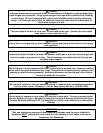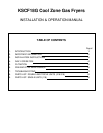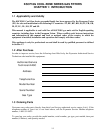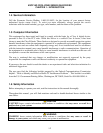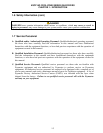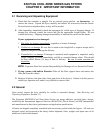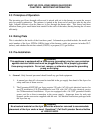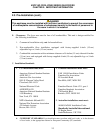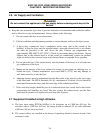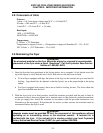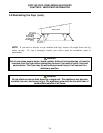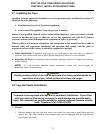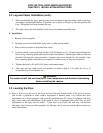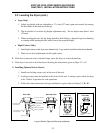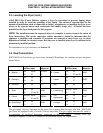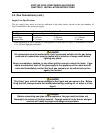
KSCF18G COOL ZONE SERIES GAS FRYERS
CHAPTER 2: IMPORTANT INFORMATION
2-4
2.6 Air Supply and Ventilation
DANGER
Do not connect this appliance to the gas supply before reviewing each step in this
section.
A. Keep the area around the fryer clear to prevent obstruction of combustion and ventilation airflow
and to allow for service and maintenance. Always adhere to the following:
1. Do not connect this fryer to an exhaust duct.
2. Follow installation and adjustment procedure to ensure adequate airflow to the fryer system.
3. A heavy-duty, commercial fryer’s combustion wastes must vent to the outside of the
building. A deep-fat fryer must be installed under a powered exhaust hood, or an exhaust
fan must be provided in the wall above the unit. Exhaust gas temperatures are
approximately 800-1000°F (427-538°C). Check air movement during installation. Strong
exhaust fans in the exhaust hood or in the overall air conditioning system can produce
slight air drafts in the room and cause erratic burner flames or improper fryer operation.
4. Do not place the fryer’s flue outlet directly into the plenum of the hood, as it will affect the
gas combustion of the fryer.
5. Never use the interior of the fryer cabinet for storage or store items on shelving over or
behind the fryer. Exhaust temperatures can exceed 800°F (427ºC) and may damage or
melt items stored in or near the fryer.
6. Adequate distance must be maintained from the flue outlet of the fryer(s) to the lower edge
of the filter bank. Per NFPA Standards No. 96, a minimum of 18-inches (45-cm) should be
maintained between the flue(s) and the lower edge of the exhaust hood filter.
7. Filters and drip troughs should be part of an industrial hood, but consult local codes before
constructing and installing any hood. The duct system, the exhaust hood, and the filter
bank must be cleaned on a regular basis and kept free of grease.
2.7 Equipment Installed at High Altitudes
A. The fryer input rating [BTU/hr (kW/hr)] is for elevations up to 2,000 feet (610 m). For
elevations above 2,000 feet (610 m), the rating should be reduced 4% for each additional
1,000 feet (305 m) above sea level.
B. The correct orifices are installed at the factory if operating altitude is known at time of the
customer’s order.



